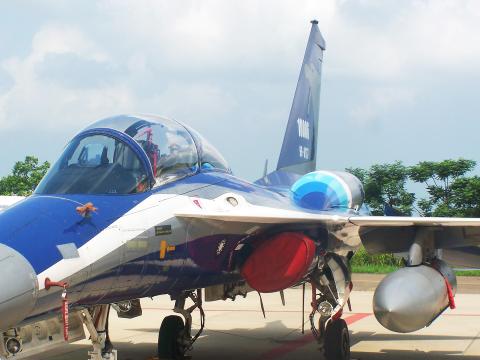State-owned Aerospace Industrial Development Corp (AIDC, 漢翔航空) is facing promising prospects for the coming years, with an advanced trainer program in the works and the likelihood of a major role in a possible F-16A/B upgrade project.
One of the main projects AIDC is working on is a new advanced and completely indigenous trainer, Mike Lee (李適彰), secretary-general of the National Defense Industrial Association of Sino (中華國防工業發展協會), told the Taipei Times on the sidelines of the Taipei Aerospace and Defense Technology Exhibition yesterday.
The firm has been working on a XAT-5 prototype, a twin-engine trainer that, according to some industry analysts, could be based on the Indigenous Defense Fighter’s (IDF) airframe.

Photo: J. Michael Cole, Taipei Times
Although he would not provide a time frame and said the air force had yet to green-light a specific model, Lee, who also serves as a special assistant to AIDC chairman Jason Liu (劉介岑), said the next few years would be the perfect time to introduce a new trainer to replace the twin-engine AT-3 — also manufactured by AIDC — that entered service in 1984.
Turning to the mid-life upgrade of Taiwan’s 130 F-CK-1A/B “Ching Kuo” IDFs, Lee said work on the first 71 aircraft was continuing and provided the air force had the budget, a second-phase upgrade, which would complete the remainder of the fleet, could be launched at some point. The first phase of the program has delivered six upgraded aircraft so far.
The configurations involved in the second-phase upgrades are still under discussion between AIDC and the air force, Lee said.
AIDC is also likely to play a role on the Lockheed Martin F-16s.
Not only could the firm be assigned some subcontracting work on the 66 new F-16C/Ds Taiwan has been requesting from the US since 2007, but the previous day a senior official at Lockheed told the Taipei Times that most of the work on the US$4.5 billion program to upgrade Taiwan’s 144 F-16A/Bs would be carried out in Taiwan.
Given the great similarities between the IDF and the F-16, and AIDC’s experience handling both, it is very likely that AIDC would get the contract for the F-16A/B upgrade, though ultimately the decision lies with the air force, Lee said.
The US is expected to announce its final decision on the F-16C/D sale and the F-16A/B upgrade package on Oct. 1.
It has been speculated that if Taiwan fails to obtain the F-16C/Ds, AIDC could proceed with the manufacture of the IDF-II “Goshawk” joint strike fighter, which comes with a larger payload and what is known as a conformal fuel tank that provides greater range.
A model Goshawk was displayed at the launch ceremony for the refurbished IDFs in Greater Taichung on June 30.
Depending on budgets and requirements set by the air force, Lee said AIDC could also embark on a fifth-generation fighter aircraft development program, but he did not elaborate nor did he tie a decision to any outcome on the F-16C/Ds.
Although it could have its hands full if all the programs were to occur simultaneously, Lee said AIDC currently had the manpower and technical base to accomplish all of the tasks.

The US government has signed defense cooperation agreements with Japan and the Philippines to boost the deterrence capabilities of countries in the first island chain, a report by the National Security Bureau (NSB) showed. The main countries on the first island chain include the two nations and Taiwan. The bureau is to present the report at a meeting of the legislature’s Foreign Affairs and National Defense Committee tomorrow. The US military has deployed Typhon missile systems to Japan’s Yamaguchi Prefecture and Zambales province in the Philippines during their joint military exercises. It has also installed NMESIS anti-ship systems in Japan’s Okinawa

‘WIN-WIN’: The Philippines, and central and eastern European countries are important potential drone cooperation partners, Minister of Foreign Affairs Lin Chia-lung said Minister of Foreign Affairs Lin Chia-lung (林佳龍) in an interview published yesterday confirmed that there are joint ventures between Taiwan and Poland in the drone industry. Lin made the remark in an exclusive interview with the Chinese-language Liberty Times (the Taipei Times’ sister paper). The government-backed Taiwan Excellence Drone International Business Opportunities Alliance and the Polish Chamber of Unmanned Systems on Wednesday last week signed a memorandum of understanding in Poland to develop a “non-China” supply chain for drones and work together on key technologies. Asked if Taiwan prioritized Poland among central and eastern European countries in drone collaboration, Lin

ON ALERT: Taiwan’s partners would issue warnings if China attempted to use Interpol to target Taiwanese, and the global body has mechanisms to prevent it, an official said China has stationed two to four people specializing in Taiwan affairs at its embassies in several democratic countries to monitor and harass Taiwanese, actions that the host nations would not tolerate, National Security Bureau (NSB) Director-General Tsai Ming-yen (蔡明彥) said yesterday. Tsai made the comments at a meeting of the legislature’s Foreign Affairs and National Defense Committee, which asked him and Minister of National Defense Wellington Koo (顧立雄) to report on potential conflicts in the Taiwan Strait and military preparedness. Democratic Progressive Party (DPP) Legislator Michelle Lin (林楚茵) expressed concern that Beijing has posted personnel from China’s Taiwan Affairs Office to its

BACK TO WORK? Prosecutors said they are considering filing an appeal, while the Hsinchu City Government said it has applied for Ann Kao’s reinstatement as mayor The High Court yesterday found suspended Hsinchu mayor Ann Kao (高虹安) not guilty of embezzling assistant fees, reducing her sentence to six months in prison commutable to a fine from seven years and four months. The verdict acquitted Kao of the corruption charge, but found her guilty of causing a public official to commit document forgery. The High Prosecutors’ Office said it is reviewing the ruling and considering whether to file an appeal. The Taipei District Court in July last year sentenced Kao to seven years and four months in prison, along with a four-year deprivation of civil rights, for contravening the Anti-Corruption